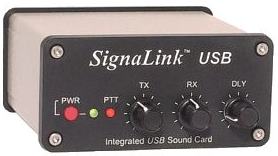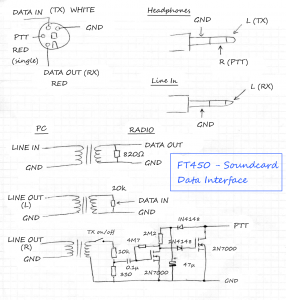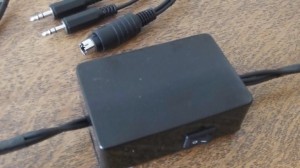A while back, I borrowed a Tigertronics SignaLink to operate data modes. This worked really well, so I looked into buying one. They are quite expensive though… So I thought I’d build one.
To simplify things I decided to use my laptop’s internal soundcard. Data in and out seemed simple enough; I was going to use audio transformers to isolate the transceiver from the PC. I wanted the PTT line to be controlled by the right channel, because you can configure fldigi to put out the signal on the left channel and a constant tone on the right channel. That way I wouldn’t have to fiddle around with delays (that’s what the DLY control does on the SignaLink). My soundcard has a line in input (as opposed to a mic input) and the levels on line in / out are fairly consistent across soundcards, so I decided not to include level adjustments for TX and RX. I have included a trimmer on the output, but that is just set once and then left alone.
Something that made my PTT control more complicated was that unlike the SignaLink (which has a USB input), I did not have a source of power. Pulling PTT low (which is a digital input with a pullup) was going to prove challenging. So I designed something using a couple of MOSFETs that would be low power, and I could then essentially make it self powered. This was the circuit I came up with:
You can see that the 47uF capacitor is charged by the PTT line via a diode. When an audio signal appears on the left channel the first MOSFET amplifies it to the point that it almost reaches the supply rails. The diode to the second MOSFET then presents the positive half of this to the second MOSFET, which switches on, pulling the PTT line low. Because of the diode, the gate voltage stays high, and the MOSFET stays on. The only problem is that we now don’t have anything charging the capacitor up, so eventually this will drain below the point that it is able to turn the MOSFET on. Because we using large resistors on the first stage however, this will take several minutes, which is more than enough for our data transmission. When the audio tone is removed the leakage through the diode drains the gate voltage away and the MOSFET turns off (in practice this takes, at most, a few hundred milliseconds, but this means any audio tone will keep the second MOSFET turned on as long as the tone is present).
The final thing looked like this:
It’s not as good looking as a SignaLink, but I think it works just as well, and cost a lot less!
I am happy with this design, and it does work really well, but I would be interested to know if anyone can make something that uses even less power. [I did think about increasing the value of the resistors, but that isn’t really an option, because it then becomes very sensitive to noise]
I am using this for the PTT line on a transceiver, but I am sure this could be used for higher power switching. It would be interesting to see how much power (with a higher rated MOSFET) it could handle…



